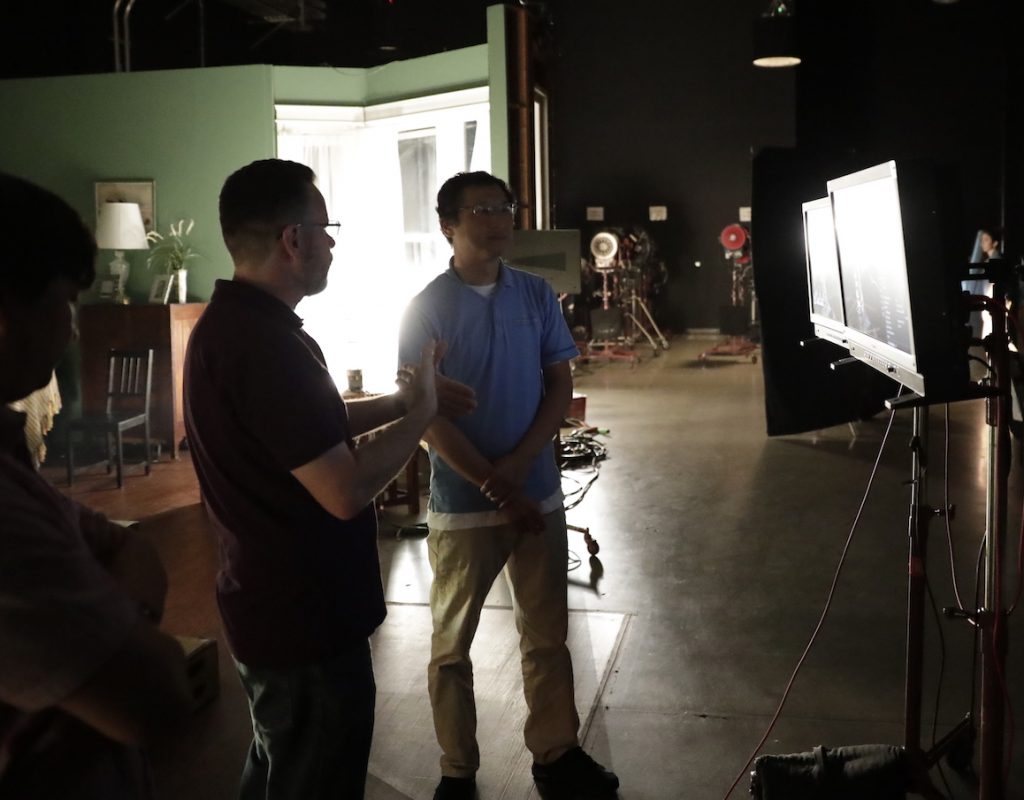This is the second installment of a six-part HDR “survival guide.” Over the course of this series, I hope to impart enough wisdom to help you navigate your first HDR project successfully. Each day I’ll talk about a different aspect of HDR, leaving the highly technical stuff for the end. You can find part 1 here.
Thanks much to Canon USA, who responded to my questions about shooting HDR by sponsoring this series.
SERIES TABLE OF CONTENTS
1. What is HDR?
2. On Set with HDR < You are here
3. Monitor Considerations
4. Artistic Considerations
5. The Technical Side of HDR
6. How the Audience Will See Your Work
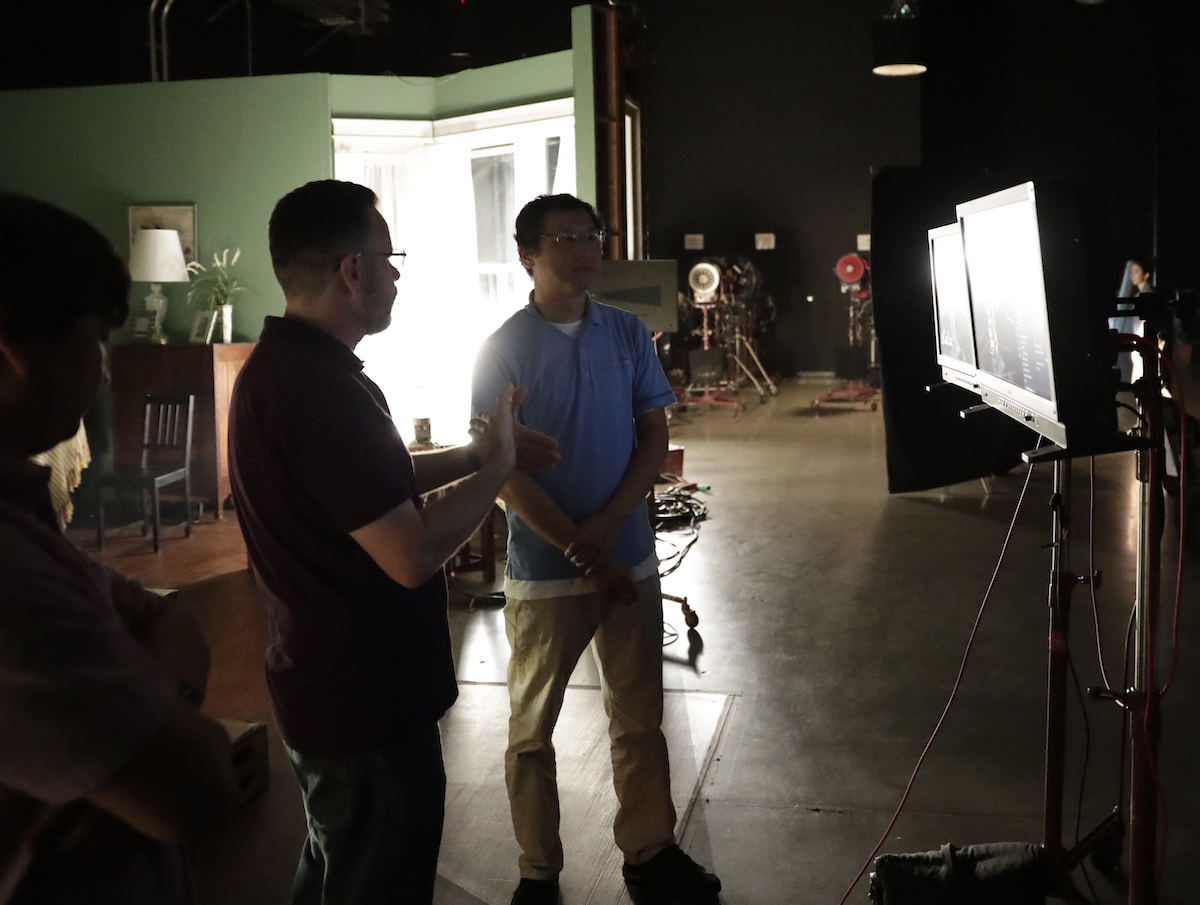
I shot my tests at the Mole-Richardson stage in downtown Pocoima. My goal: illustrate the differences between working in SDR and HDR on set.
As there’s no way to view HDR in print or on the web using standard displays, I opted to compare the SDR and HDR monitors by photographing them side-by-side with a Canon 1DX Mk2, exposing for HDR’s highlights. All image pairs were captured simultaneously, and minimally corrected for keystone distortion in Adobe® Lightroom® 6.
One of the first things I photographed was a color chart, as I wanted to ensure the best color possible when I processed the Canon 1D’s raw images at a later date. This confirmed what I’d learned elsewhere: HDR is not simply a brighter image.

Left: DP-V2410 monitor set up for SDR. Right: DP-V2410 monitor set up for HDR.
When I viewed my DSC Labs OneShotTM color chart in both SDR and HDR, the white patch appeared nearly the same brightness on both monitors. That patch reflects about 90% of the light striking it and is known as “reference white.” It is a standard in the television industry, and it falls at 100 IRE on a waveform monitor.
The white patch appears dimmer in HDR because we have the HDR Level feature set to 800 nits, to better evaluate the highlights on the C-stand. Scaling the dynamic range of the captured image to fit within that of the monitor causes mid-tones and shadows to darken, but it opens up the highlights for critical evaluation of detail and color.
The specular highlight on the C-stand arm and knuckle is flat in SDR, while the same highlight in HDR, viewed through HDR range, shows much more contrast and shape. HDR doesn’t “roll off” highlights; rather, it gives them room to breathe.
In SDR, the white and black chips on this chart are where highlight dynamic range ends. In HDR, they are where dynamic range begins.
Mid-tones are key in SDR as they retain the most contrast. Nearly every WYSIWYG gamma curve focuses on making the middle four stops of dynamic range as contrasty as possible, while compressing the highlights and shadows so that viewers still see some detail but without much contrast. They “flatten out,” although we almost never notice because the human visual system does as well.
For example, a variation of one stop in the middle of the SDR tonal range is the difference between middle gray and light flesh tone, but the difference of a stop between five and six stops above middle gray is the difference between barely different shades of white. Detail—which is primarily revealed through contrast—is retained, but just barely.
The same happens in SDR shadows, but to a lesser extent. The difference between five and six stops below middle gray is often noticeable in SDR but this is because modern SDR LED displays aren’t very dark, which results in natural lowlight compression.
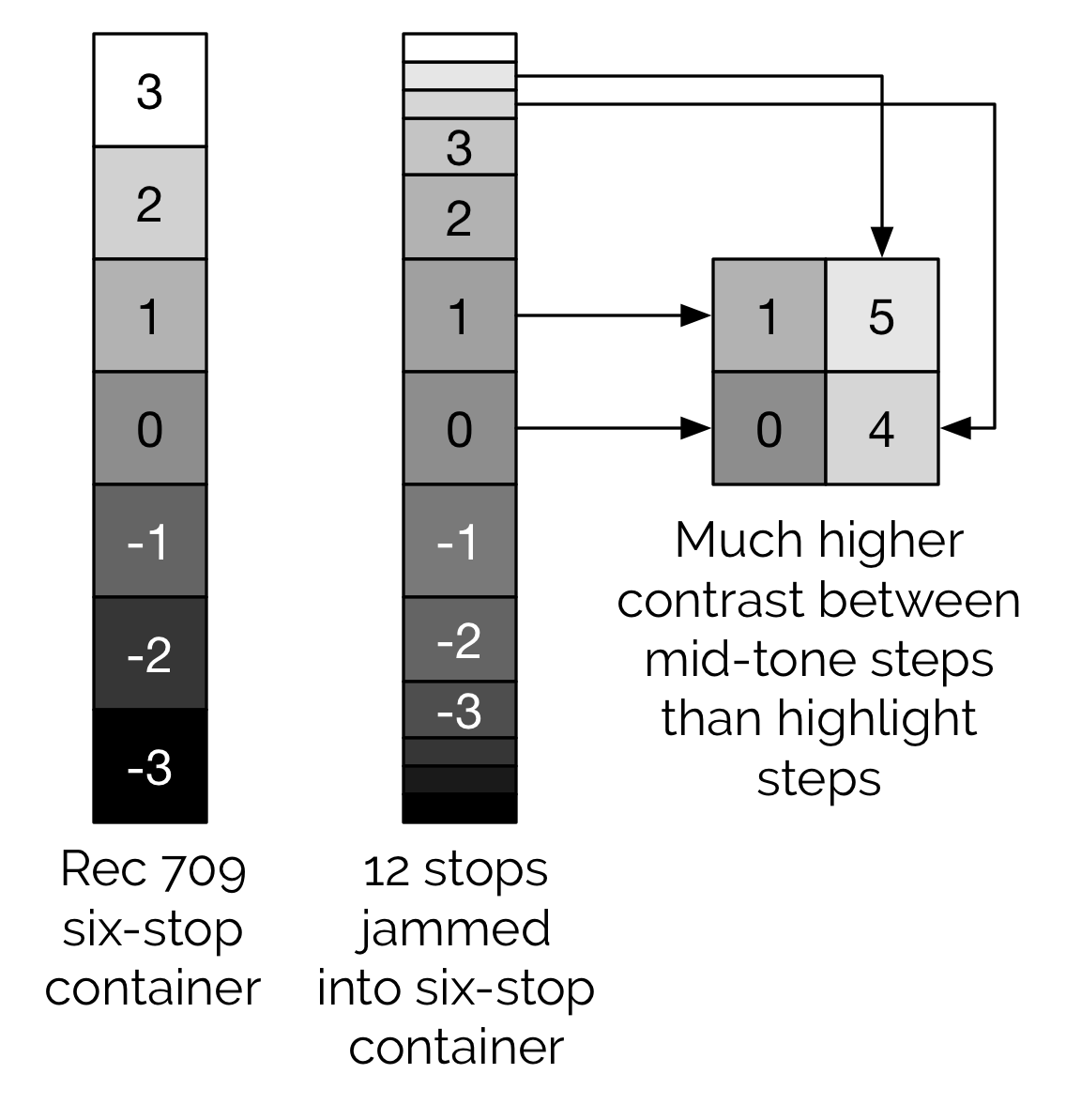
(above) Tones at the exposure limits are compressed and lose contrast in SDR, while in HDR they retain much the same contrast that the camera saw at the time they were captured.
As the HDR display’s dynamic range and color gamut better matches what the camera saw in the first place, it reproduces tones and hues that are more true to life than ever seen before on a television display, and certainly with more contrast and vividness than can be seen in traditional digital cinema theaters.
I’ve coined a phrase for this: “constant contrast.” Contrast occurs in equal steps across the grayscale. There is no compression in shadows or highlights, as in SDR—or even film, where highlight roll-off is part of the look. Every stop of dynamic range is equally important in HDR. (This applies primarily to image capture. Highlights and shadows may be rolled-off in the color grade or when broadcast, but it’s good practice to assume this won’t happen.)
Update: Nick Shaw, of Antler Post, points out that true “constant contrast” would not reproduce the scene in a visually pleasing way due to two visual quirks:
The Hunt Effect: Colorfulness increases with luminance. At high luminance, an object will look much more colorful than the same object at low luminance.
The Stevens Effect: Contrast increases with luminance. At high luminance, whites appear whiter and blacks appear blacker.
Because of this, there is always some rendering intent applied to an HDR image, as a scene without any perceptual modification will not produce the desired result.
The core of ACES can be found at the heart of Canon HDR monitors, so there is always an output transform applied to the image to account for these characteristics, among others.
Rather than “constant contrast,” the better phrasing might be “perceived constant contrast.”
Consumer HDR specifications call for displays to have a dynamic range of at least 13 stops to be considered HDR capable, which is more than twice that of SDR. If two tones on set differ in brightness by one stop, they will likely appear to differ by one stop on a consumer display at a later date, no matter where they fall within the camera’s dynamic range. In SDR this is true of only the middle two to four stops of dynamic range.
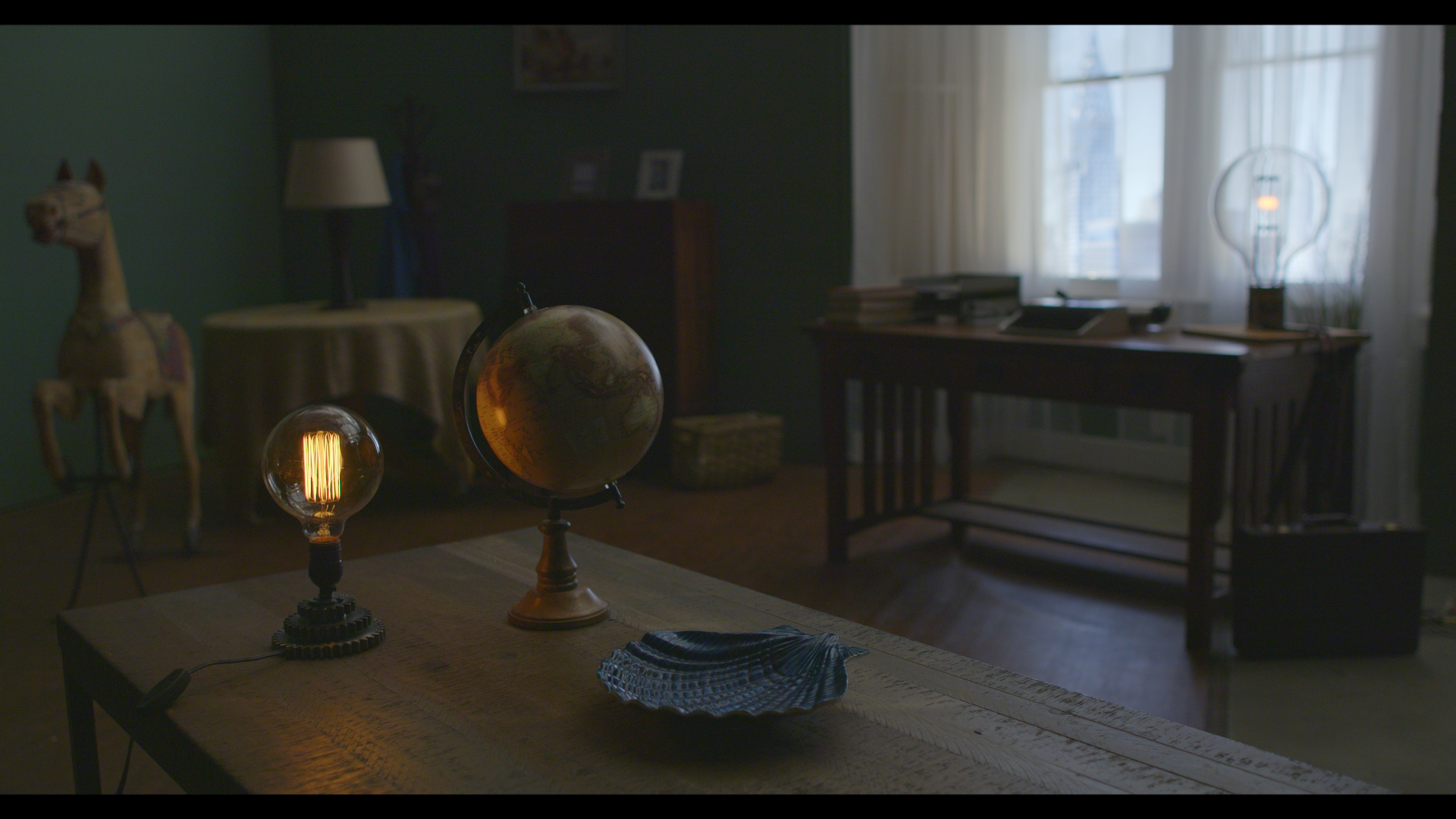
(above) This wide shot, captured in Canon Raw/Canon Log 2 and exported from DaVinci Resolve® 12.5, was lit almost entirely by two 5Ks and a nine-light Maxi Brute bounced off the backdrop outside the window. Some of that light bounced off the ceiling and added some fill to the set, but the majority of the light came through the window.
The C300 MarkII camera captured nearly the entire dynamic range of the Mole-Richardson scene, from the Translight background at six stops above middle gray (reflected) to the foreground at F0.5 (incident). When shooting for SDR I’d be happy to see any detail outside of that window, regardless of how flat or desaturated it might be. I can also see detail in nearly every shadow. This image looks much like what I saw by eye.
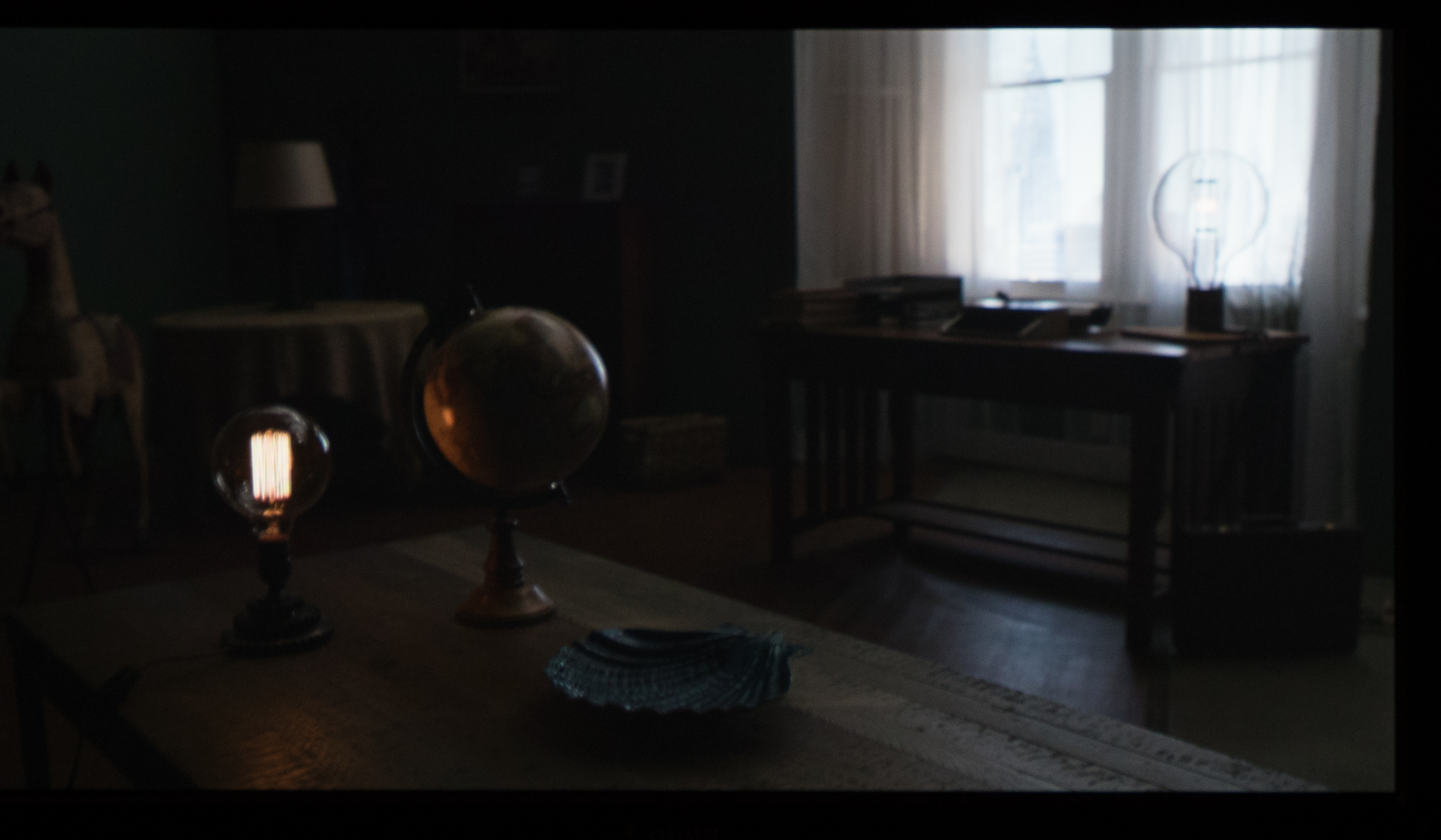
(above) This frame was captured by DSLR from a Canon DP-V2410 monitor screen displaying an SDR image. The exposure is set to capture highlights, as the still camera’s dynamic range cannot capture the full contrast range of an HDR display.
The image above is typical of what happens when we shoot a high contrast scene with a wide dynamic range camera and view it on a limited contrast screen: we’re so thrilled that we can see ANY detail outside that window that we don’t mind that it’s low contrast and desaturated. We’re just happy that it’s not “clipped video white.”
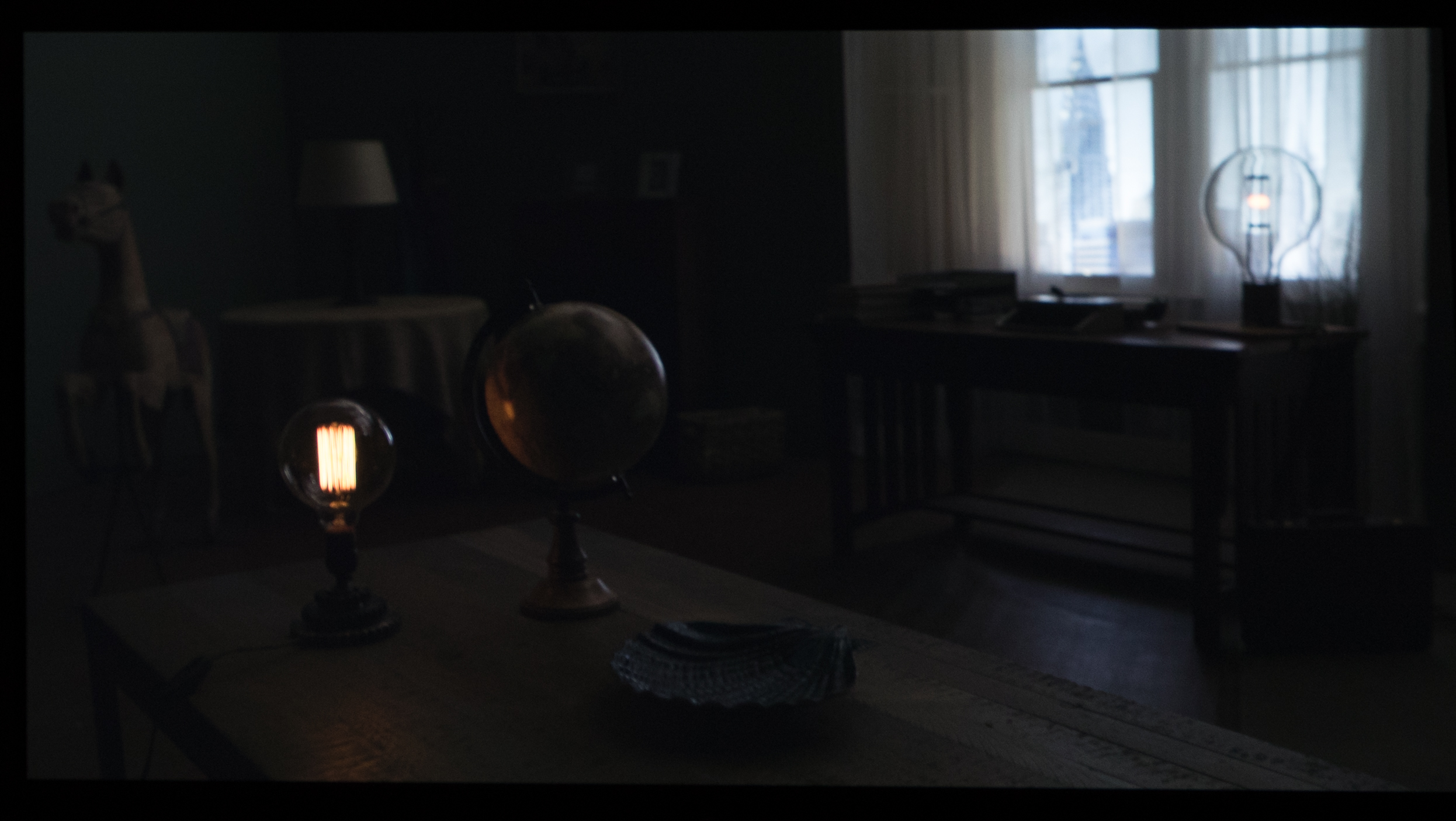
(above) This next frame was captured simultaneously from an adjacent DP-V2410 monitor set up for 400-nit HDR. The increased contrast and color gamut reveals the golden hue of the lightbulb’s filament against the window, a detail that is completely lost in SDR, while also revealing the color of the sky and the complex textures of the building exterior.
HDR shadows are much darker than SDR: the top of the globe, lit by bounce light off the ceiling, is a darker tone in HDR, as is the side of the globe lit by the smaller lightbulb in the foreground. The DP-V2410’s blacks are significantly deeper than those of an SDR monitor, and they appear as significantly crushed blacks on a DSLR with inferior dynamic range.

Left: SDR. Right: HDR.
It’s impressive to see so much detail in a backdrop that was lit bright enough that it illuminated an interior set. Also, notice how much darker the shadows are in HDR. The eye can see this, although a still camera can’t.
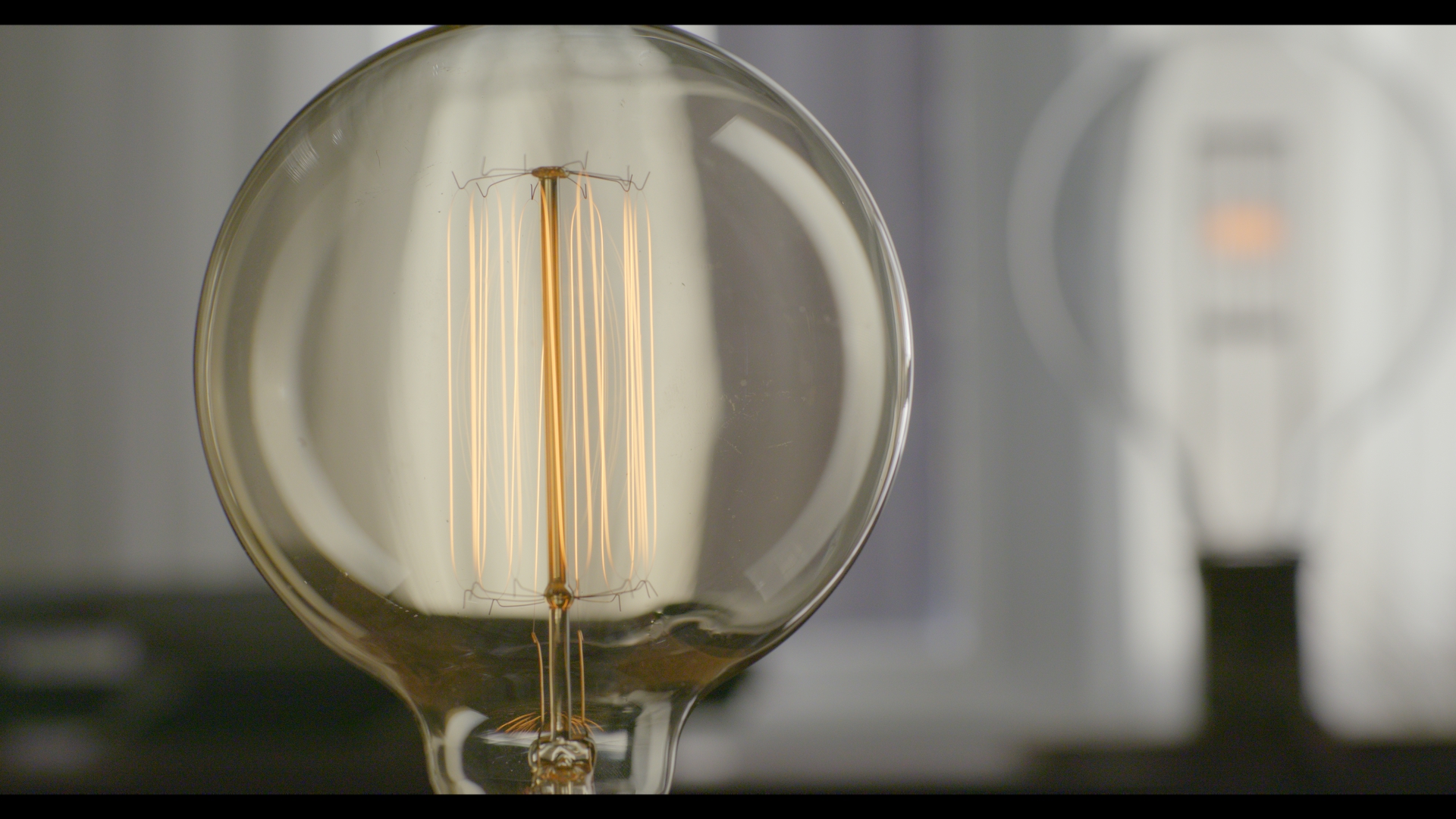
(above) Frame grab exported from Resolve.
This is a flattened version showing all the image data that’s available for grading.
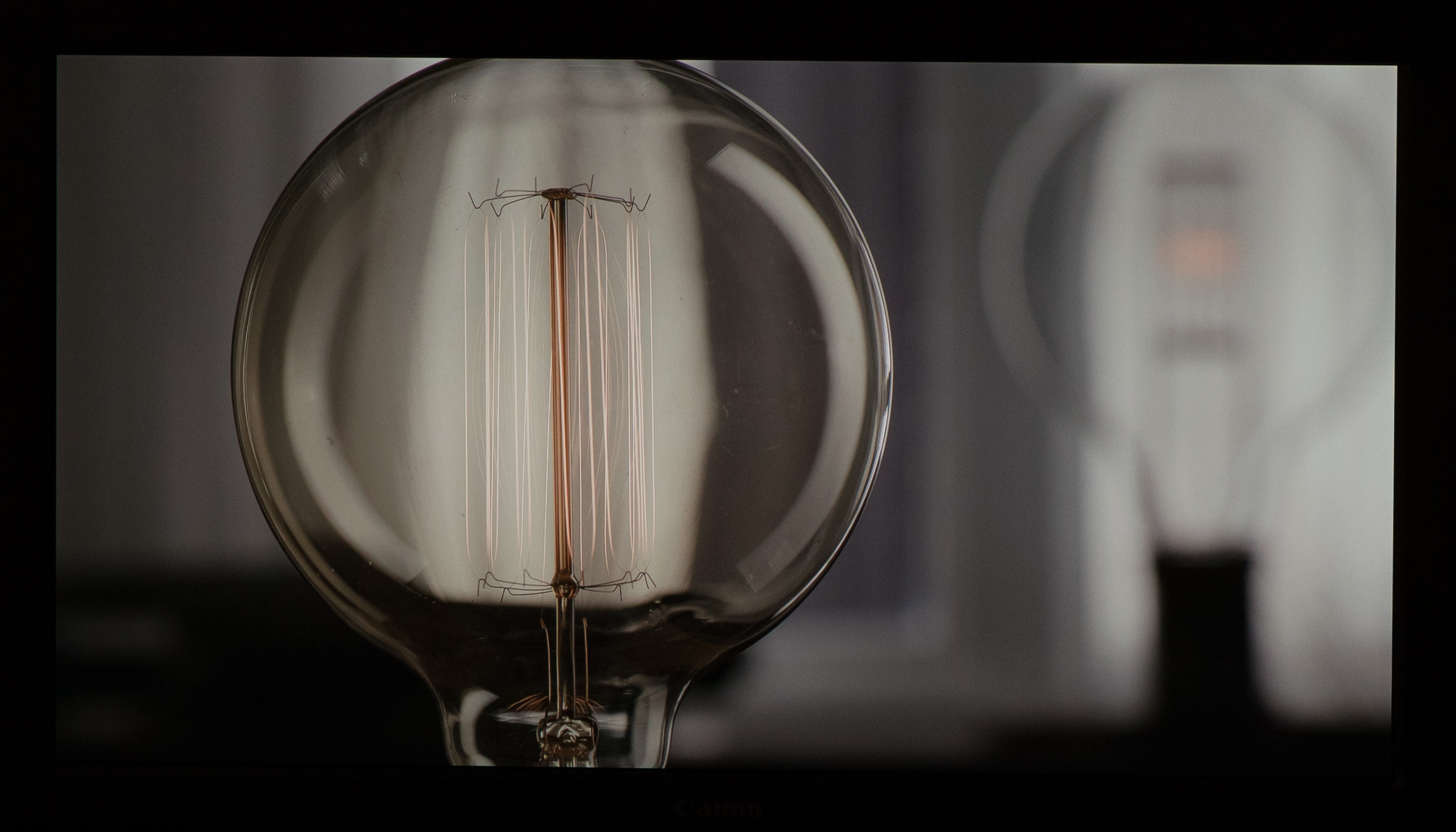
(above) This is a still photograph taken of the DP-V2410’s screen while in SDR mode. The still camera captures nearly the entire dynamic range of the image.
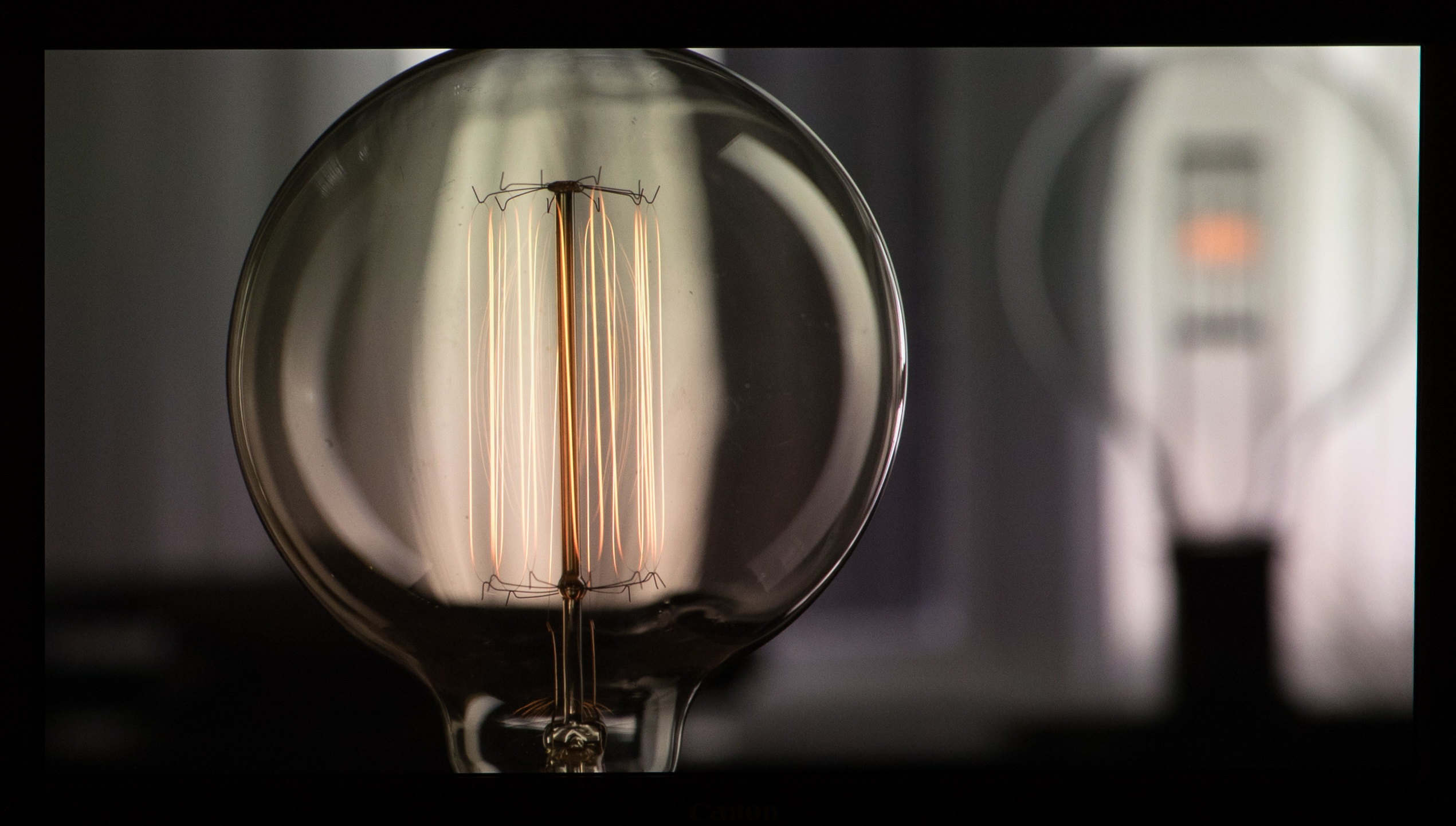
(above) The same image, photographed with the DP-V2410 set to HDR mode. Highlights are much brighter and more saturated than in SDR, and the increased shadow contrast exceeds the dynamic range of the still camera.
The differences between SDR and HDR are striking. The SDR bulb looks bland by comparison. The filament is bright but not saturated, there’s no detail in the curtains in the background, and there’s very little color saturation in the highlights. The Rec 709 color gamut is so small, and the dynamic range is so low, that any saturated hue that falls too far outside the mid-tone range (plus or minus two stops) will flatten out and desaturate.
The HDR bulb’s filaments, however, are golden yellow. Detail is visible in the curtains behind the background lightbulb, and the warmth of that bulb’s filament clearly separates it from the background. In the SDR image, there’s no difference in hue between the color of the curtains viewed directly and their color as seen through the bulb’s tinted glass, but the HDR image reveals a significant difference in both hue and brightness. HDR’s deeper shadows make the bulb appear more three dimensional due to the increased contrast between the light and dark reflections in its surface.
The DP-V2410 monitor, in its native mode, adds two stops of dynamic range to the typical SDR set. That, and the increased color gamut, allow highlights to retain their saturated hues to the point that the monitor screen feels more like a window than a display. HDR’s blacks are much sharper and richer to the point where they feel “chiseled,” as if they’ve been carved out of the display.
Throwing focus to the background is revealing:
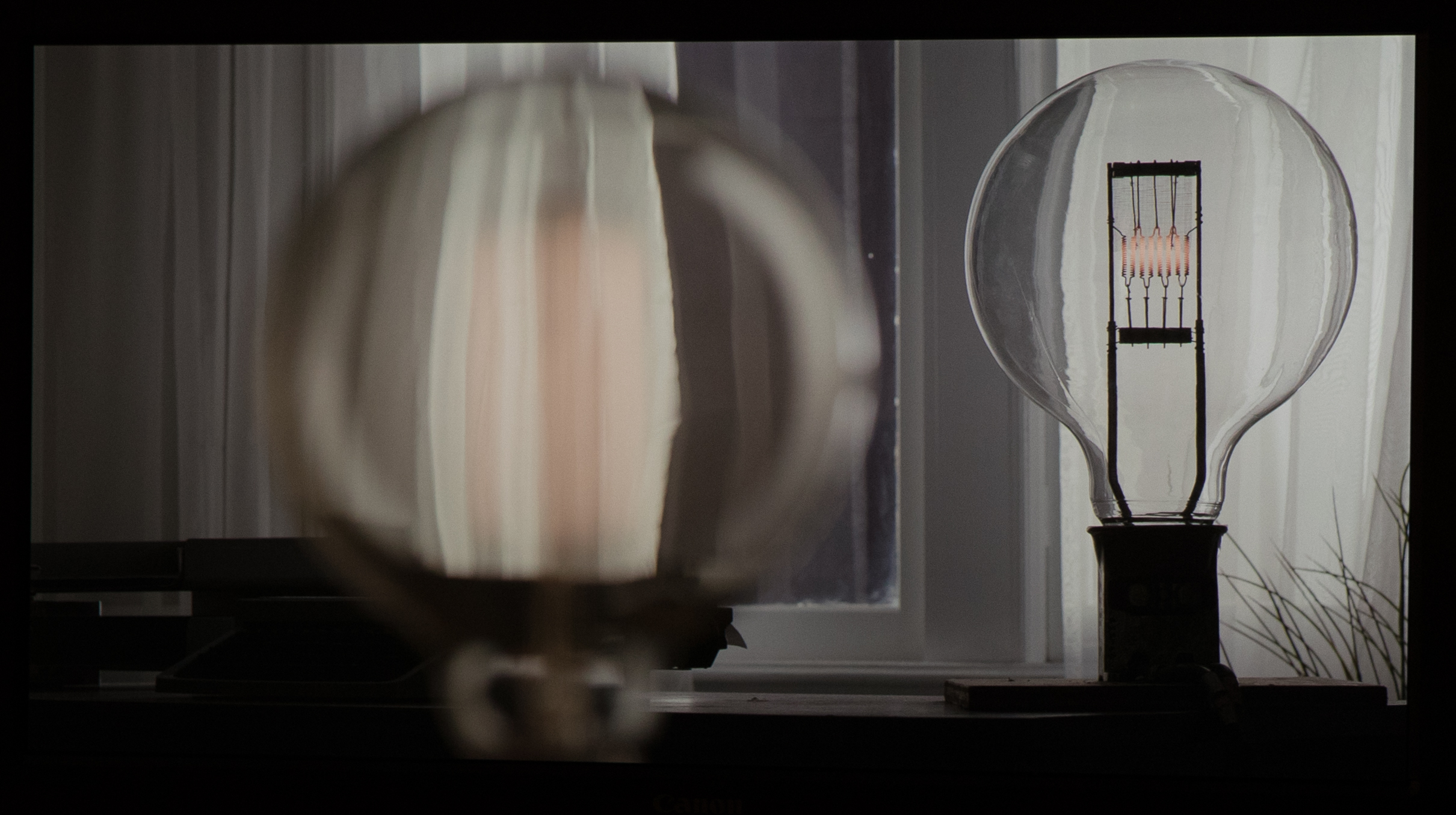
(above) SDR
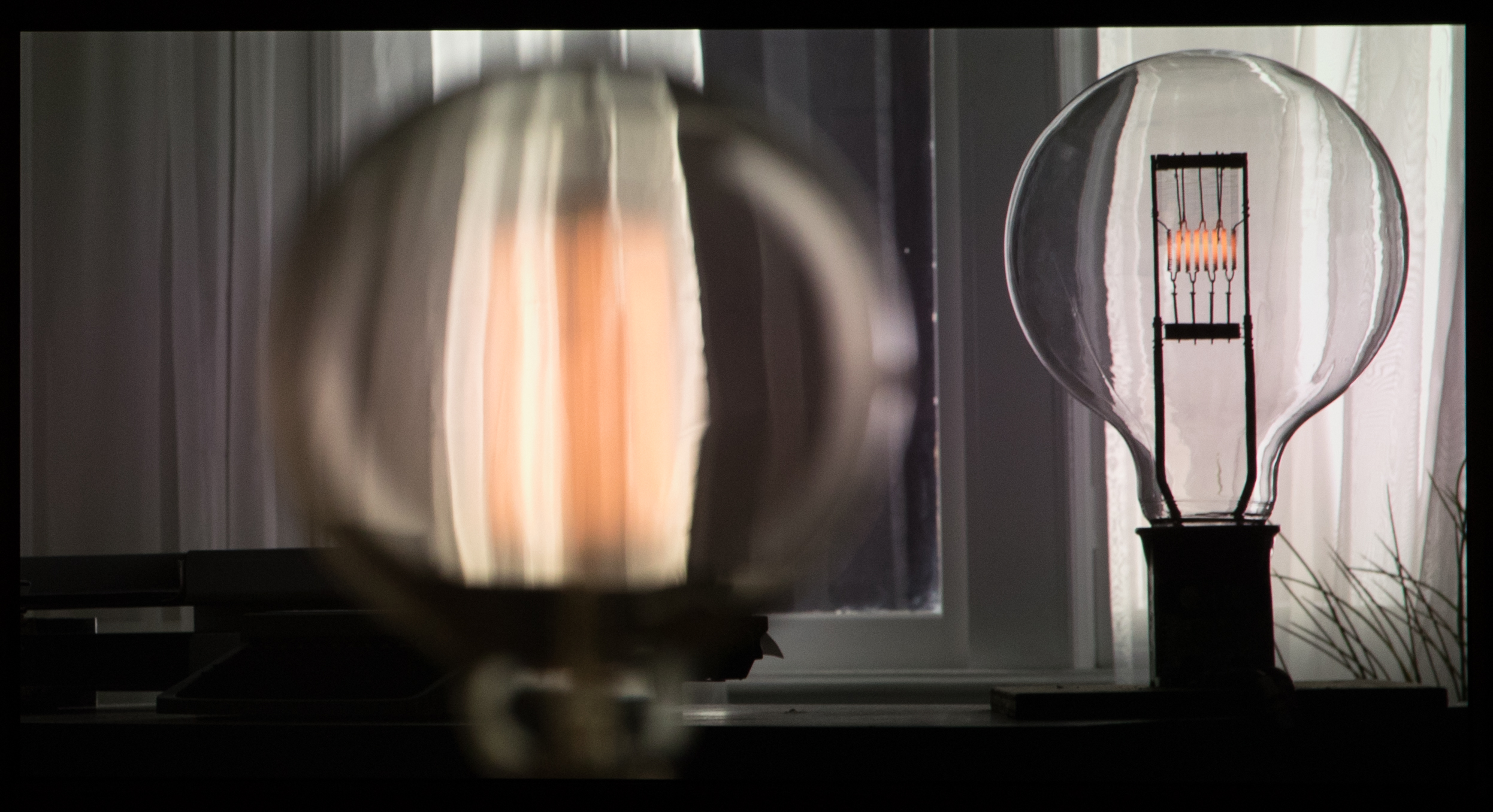
(above) HDR
The soft but warm foreground filament almost disappears in the SDR image, as reduced contrast and saturation causes it to blend with the reflection of the key light in the glass bulb. The HDR image, with its increased color gamut and highlight contrast, shows clear separation between the reflection in the bulb and the filament itself. This illustrates not only HDR’s broader color gamut (currently defined as reproducing at least 90% of the P3 color gamut), but also what happens when highlights are given room to “breath.” Highlight roll-off preserves some detail when mapping a high dynamic range image to a low dynamic range display, but much more is lost than retained.
The increased highlight contrast in HDR is startlingly obvious even when photographing something as simple as a sheet of paper. Here we lit a product manual such that the vertical surface of the rolled-back page received several stops more light than that of the flat page:
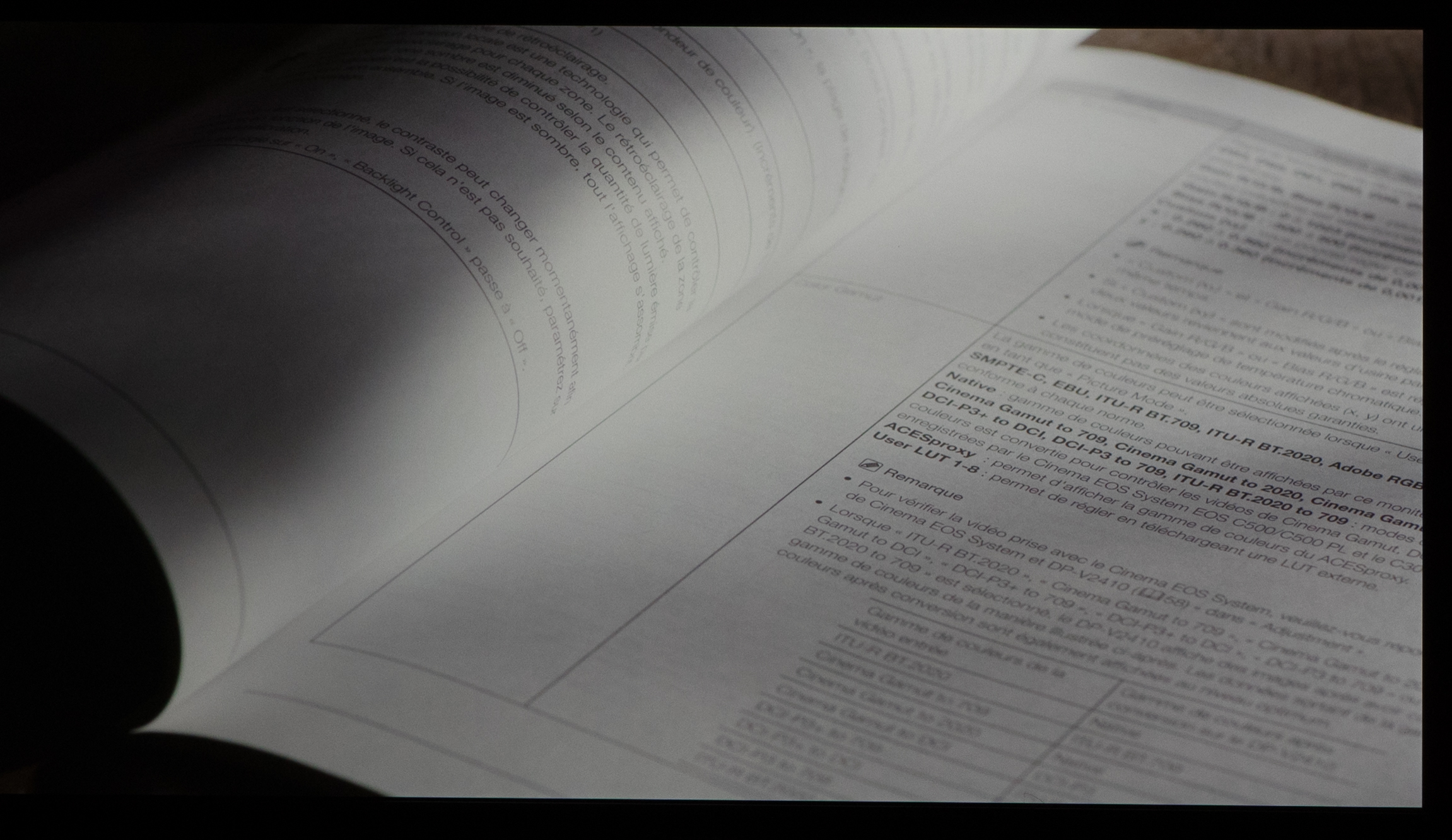
(above) SDR
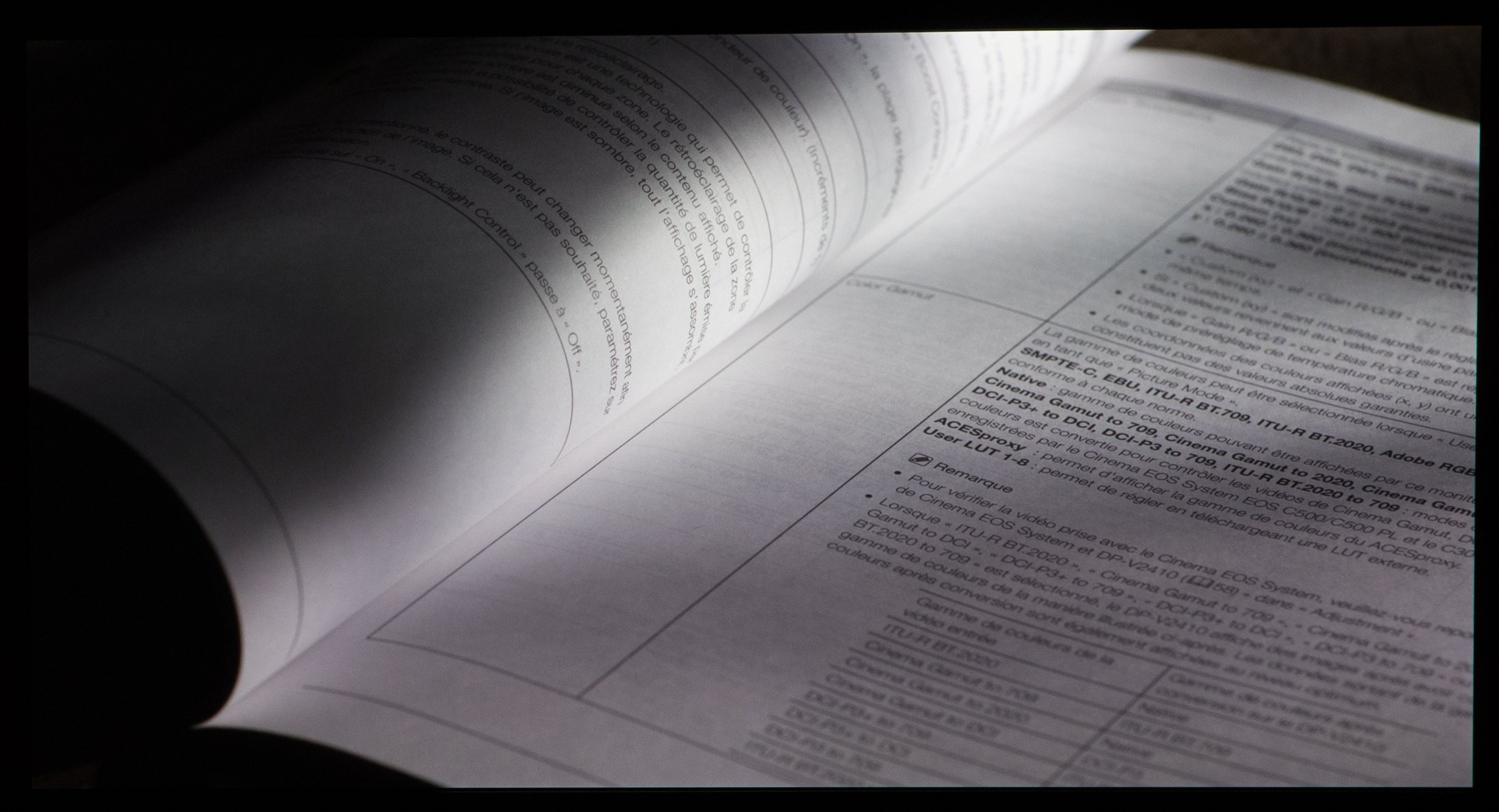
(above) HDR
SDR’s highlight compression is obvious, whereas the HDR image looks much the same as what I remember seeing by eye. Highlight detail and contrast are retained, and HDR’s increased shadow contrast makes the transition between highlight and shadow look harder and sharper than in SDR.
The typewriter (below) was backlit by a 4’x4’ frame of heavy diffusion with full CTO gel clipped across the bottom and full CTB clipped across the top.
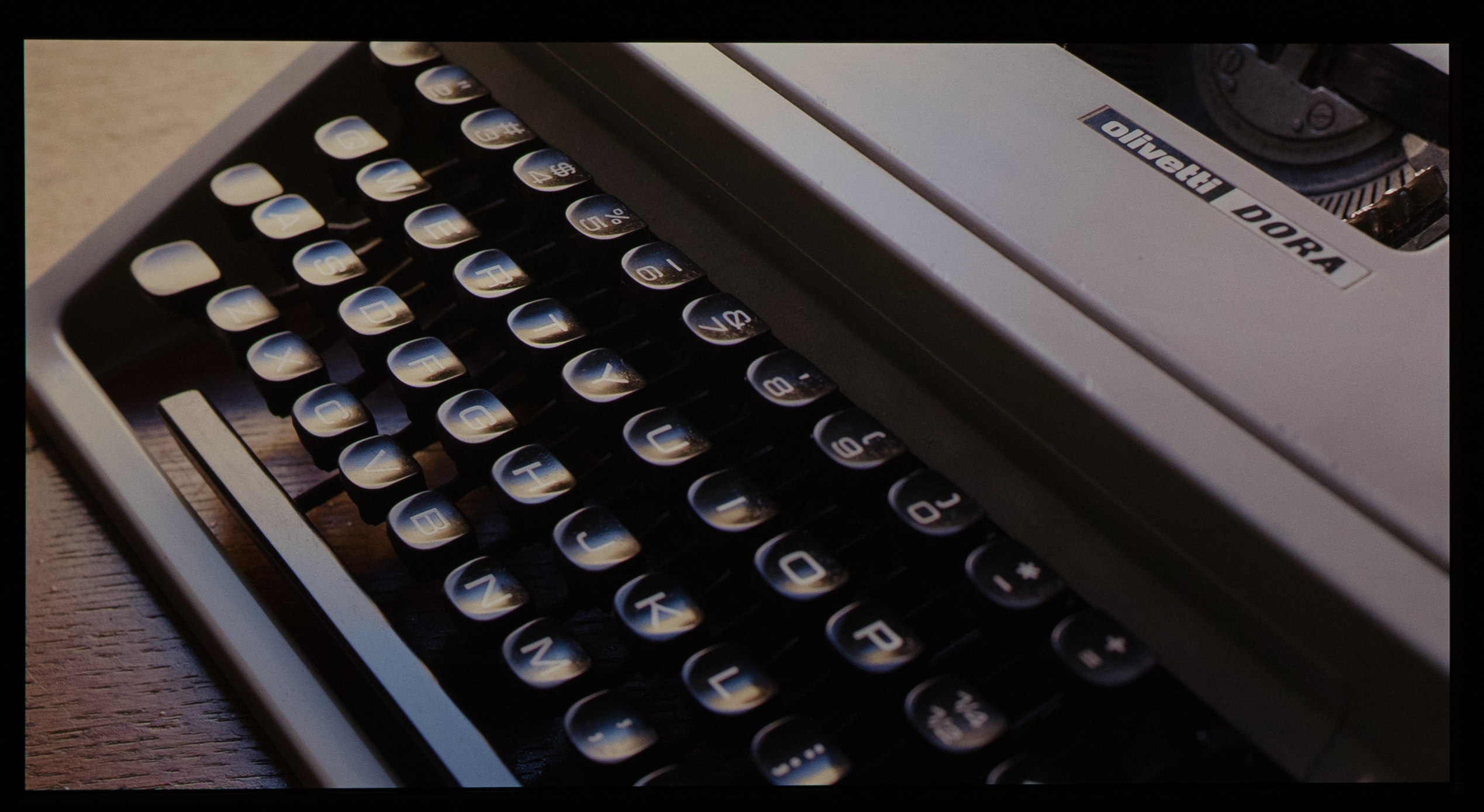
(above) SDR
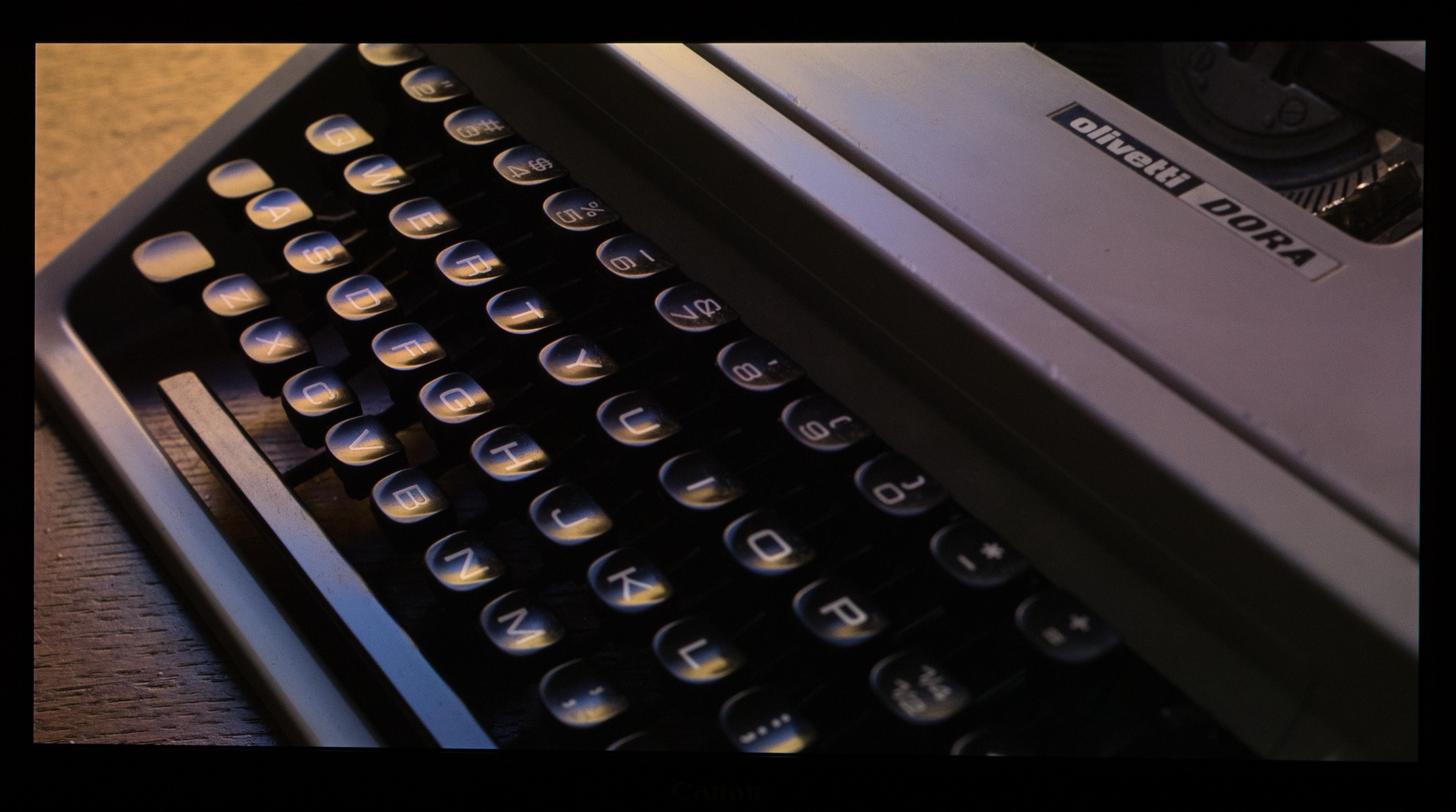
(above) HDR
The increased color saturation and contrast in the HDR highlights is stunning, and the depth of the shadows makes the keys feel three dimensional. The SDR keys feel flat and dull by comparison.
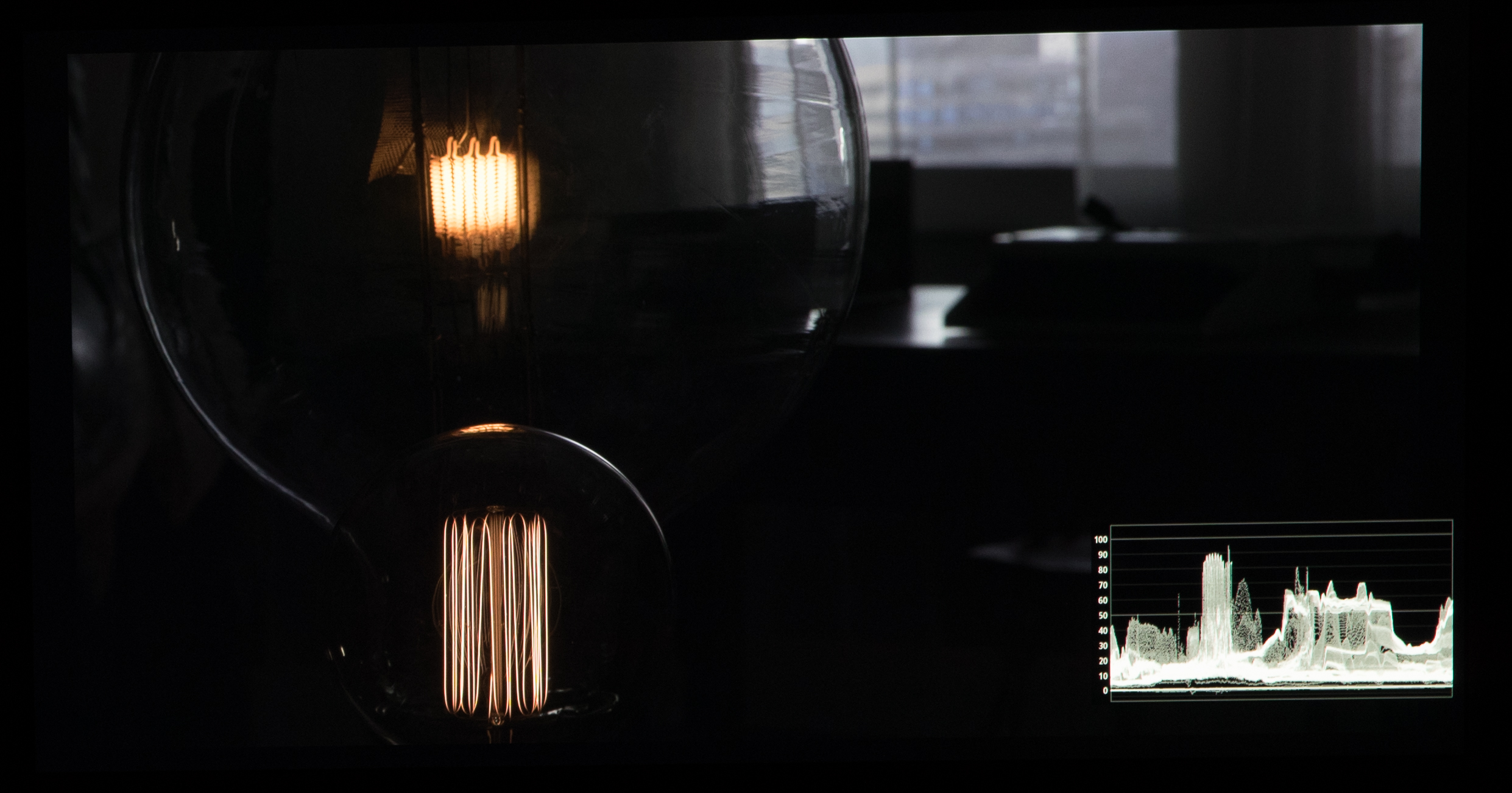 (above) HDR waveform via DSLR, exposed for highlights. The foreground lightbulb trace is buried in that of the background bulb.
(above) HDR waveform via DSLR, exposed for highlights. The foreground lightbulb trace is buried in that of the background bulb.
Adjacent light sources don’t always stand apart on waveform monitors. It can be difficult to get a sense of how bright either of these sources are simply by looking at waveform peaks. The HDR monitor not only visually reveals the brightness and saturation differences between the two filaments, which will appear to be of similar brightness and saturation in SDR, but it is the only way to assess whether the brightness and saturation of an element within the frame is artistically appropriate.
In the image above, the HDR monitor’s waveform is looking at the input signal. Occasionally the dynamic range of the camera will exceed that of the monitor and highlights will appear visually to be clipped. In the event that it is not expedient to toggle the HDR range function to verify whether they are truly clipped, highlight integrity can be verified by looking at a log representation of the input signal.
The Canon DP-V2410 monitor can be switched into SDR mode at the touch of a function key. This is a very useful function given that SDR is not going to disappear any time soon. My parents watch TV on an old NTSC tube television that cuts the image off at title safe. No matter how stunning HDR is, they aren’t going to spend money on an HDR set—and yet they still want to see a decent image on their ancient CRT. We’ll have to keep them in mind for a bit longer.
THINGS TO REMEMBER
- HDR displays are capable of reproducing at least twice the contrast and dynamic range as SDR.
- It is not possible to “hide” flaws in highlights and shadows anymore as they will not be rolled-off, or compressed, nearly as much in HDR as they would in SDR.
- “Constant contrast” means that the camera’s dynamic range is mapped to the HDR display in a 1:1 fashion. This may change in color grading and distribution, but this is likely how you will monitor the image on set and may represent a “best case” scenario for consumer viewing.
- In general, current HDR monitors are capable of displaying P3 color. Consumer monitors must be capable of reproducing 90% of P3’s color gamut to be rated suitable for HDR.
- Color gamuts are three dimensional shapes (“color volumes”). Saturation changes with luminance. HDR highlights and lowlights are much more saturated than SDR due to expanded color gamut, dynamic range and lack of roll-off.
- Waveforms don’t tell the whole story. Display contrast is so high that an on-set monitor helps considerably in judging the physiological and emotional impact of both highlights and shadows.
- Programming will be released in both HDR and SDR for the foreseeable future. The two are so visually different that evaluating both kinds of images on set may aid in quality control.
SERIES TABLE OF CONTENTS
1. What is HDR?
2. On Set with HDR < You are here
3. Monitor Considerations < Next in series
4. Artistic Considerations
5. The Technical Side of HDR
6. How the Audience Will See Your Work
The author wishes to thank the following for their assistance in the creation of this article.
Canon USA
David Hoon Doko
Larry Thorpe
Mole Richardson
Larry Parker
Disclosure: I was paid by Canon USA to research and write this article.

Filmtools
Filmmakers go-to destination for pre-production, production & post production equipment!
Shop Now